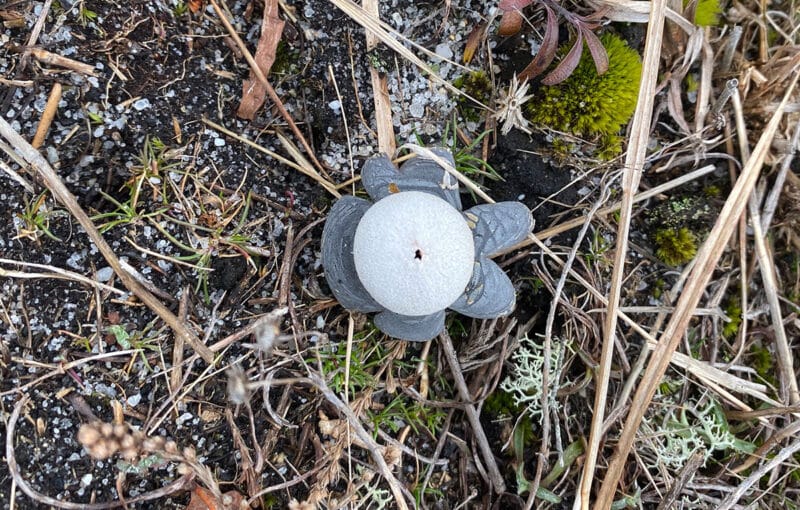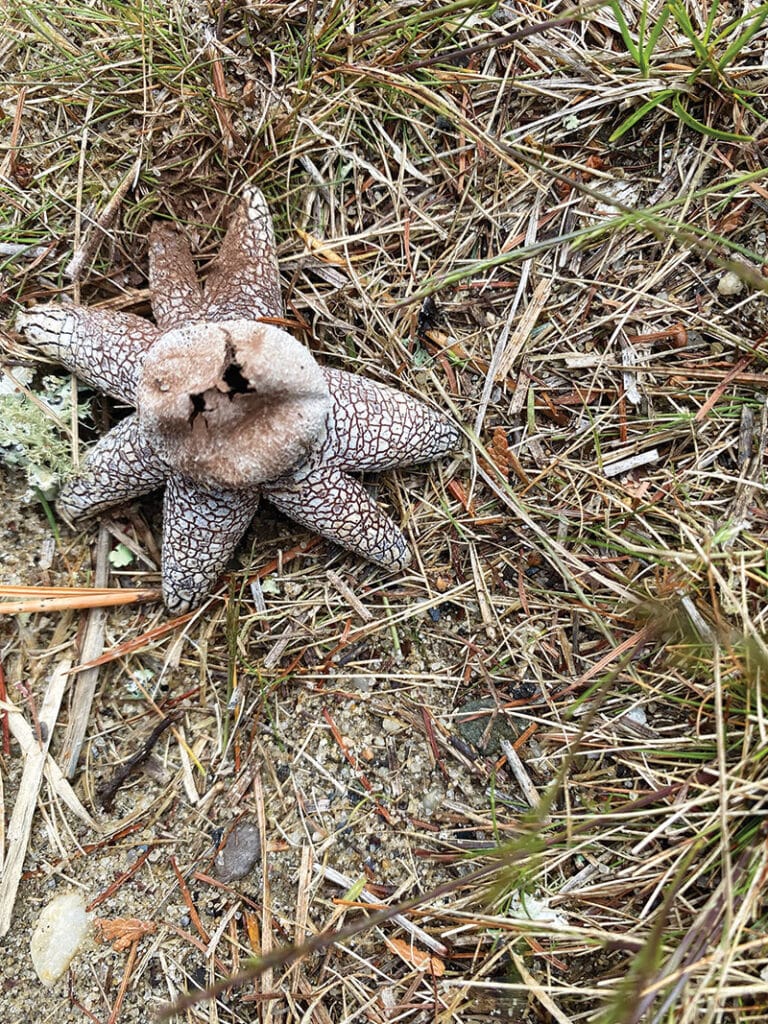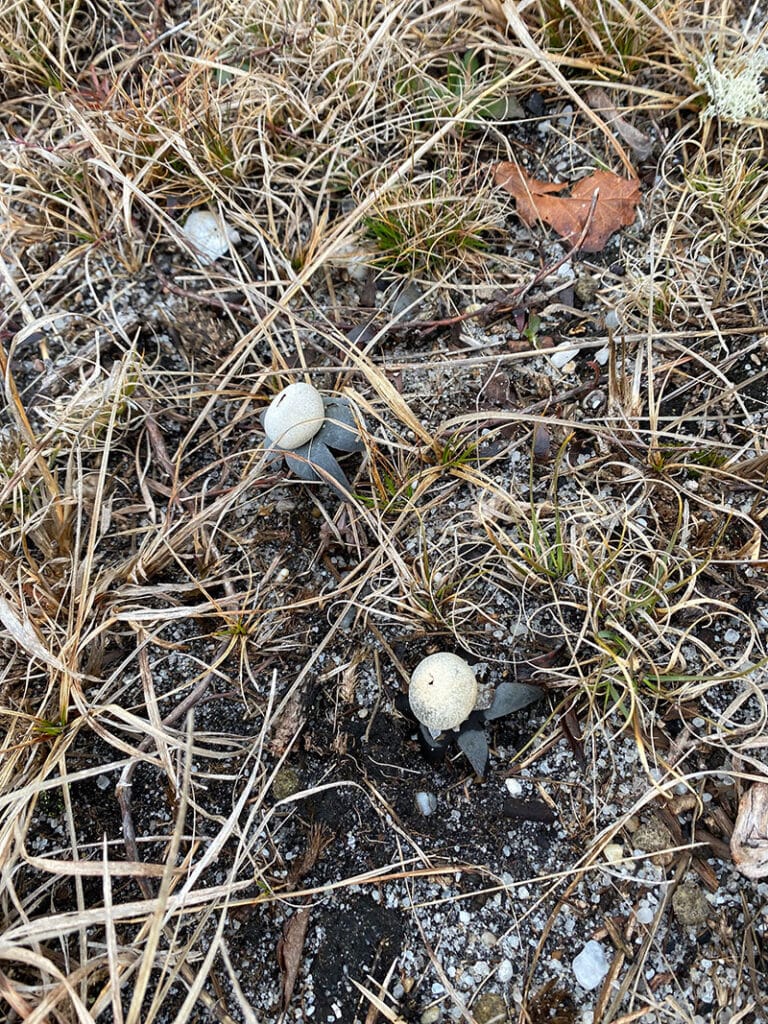by Dr. Sarah Treanor Bois
Director of Research & Education at the Linda Loring Nature Foundation
Spring on Nantucket; one day you’re frolicking in the sunshine wearing short sleeves and planning your summer garden, and the next day you’re wearing a wooly cap and down jacket to go to the grocery store. Depending on when you read this, the pendulum could be swinging in either direction. Whatever the weather, it’s always a good time to get out for a nature exploration—just make sure to dress in layers.
The recent wet weather followed by a few days of sunshine has resulted in a lot of foggy warm days: the Gray Lady is really showing up lately. Some of nature’s most under-appreciated treasures thrive in the heavy, thick air—ideal conditions for many mushrooms and other fungi. One of my favorite nature walk finds to keep an eye out for is a fungus that loves fog and sand, a true Nantucket native: the earthstar fungus.
Earthstars are fungi that look like a ping pong ball perched on a leathery star. Each has a spore sac in the center (like a puffball mushroom) with an outer leathery shell. The center is white initially, but turns brown and powdery when the spores mature. Once mature, the leathery skin splits open and the split ends winding up resembling a star measuring about 1.5-3 inches across when open.
The earthstars found on Nantucket are from the genus Astraeus, also known as the “Barometer Earthstars.” There are nine species in this genus, which are visually very similar. Only recently has DNA research split the species. In Greek mythology, Astraeus was one of the Titans, responsible for the stars. His name means “the starry one.”
This charismatic fungus is known as Barometer Earthstar because it has a strongly hygroscopic character— meaning it reacts to the level of humidity in the air. When the air is moist or when it rains, the leathery points open almost like a blossom and expose the puffball center. As the rain begins, the different parts of the hygroscopic rays absorb water at different rates, causing them to unfold to expose the center puffball. When the air is dry, the points fold up around the puffball (the spore sac) to protect it from weather and from various predators. To open can take about 45 minutes, but it can take days to close.
You might find earthstars lying loose on the surface, but they grow up from below, where the main part of the fungus lives year-round. Like many fungi, the part we see, the earthstar, is actually what is called the “fruiting body.” Earthstars are ectomycorrhizal fungi, meaning the “body” of the fungi lives in the soil. The body of the earthstar fungi is its mycelium, the underground complex of fibrous, branching hyphae. The earthstar fruiting body is how the fungi reproduces. When ready to reproduce, the mycelium develops the “earthstar” above ground. The ball-looking part is actually a spore sac. When immature, the spore sac is solid inside, but as it matures the inside changes into a mass of powdery spores. When raindrops hit the ripe spore sac, the spores puff out from a pore at the top of the sac. You can see the tiny hole at the top of the puffball portion of the earthstar where the spores will release.
When a Barometer Earthstar opens, its rays can push the fruiting body a centimeter or two above the ground like an octopus stretching its legs on the ground, increasing their spores’ chances of being scattered further. Above ground, the earthstars become detached, and wind or rain can move them, all the better to spread spores.
Underground, the fungus forms relationships with plant roots, and both fungus and plants benefit. Like many fungi, the earthstars have strong positive associations with many woodland species, pines and oaks especially for the Barometer Earthstar – both trees plentiful on Nantucket. The mutualistic association between tree roots and the mycelium of the fungus helps the trees extract nutrients (particularly phosphorus) from the soil; in exchange, the fungus receives carbohydrates from photosynthesis.
The Barometer Earthstar prefers loamy or sandy, nutrient-poor soil, such as what we primarily have on Nantucket. It often grows in open spaces, usually in clusters or groups, making it an ideal candidate to discover on a nature walk.
On-island, I have found these little treasures in multiple locations: along Linda Loring Nature Foundation trails, Surfside dune swales, Head of the Plains near pitch pine stands, in various parts of the Middle Moors, and at Camp Richards Scout Camp. Look along the edges of sandy trails, particularly after a heavy fog or rain. The loose earthstars (after opening and detaching) can persist for years. So even after they first appear, loose earthstars can be found at any time of year.
When dry, the arms of the “star” curl up. If you put your dried earthstar in a little water, the rays open up again— a magic trick of nature!
While this Nantucket native is a superstar to us, the Barometer Earthstar is actually cosmopolitan. That is, our earthstar can also be found in Europe, Asia, Africa, South America, and even Australia.





